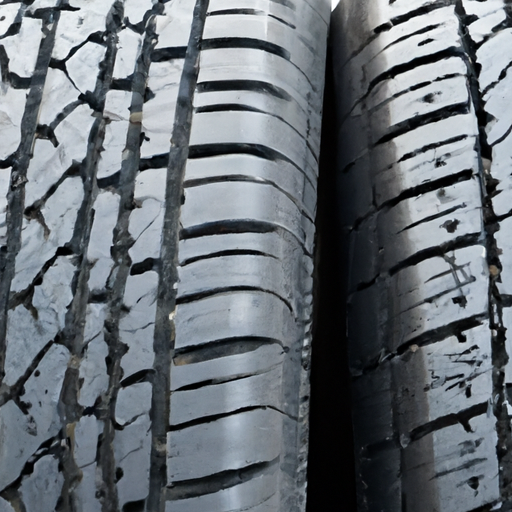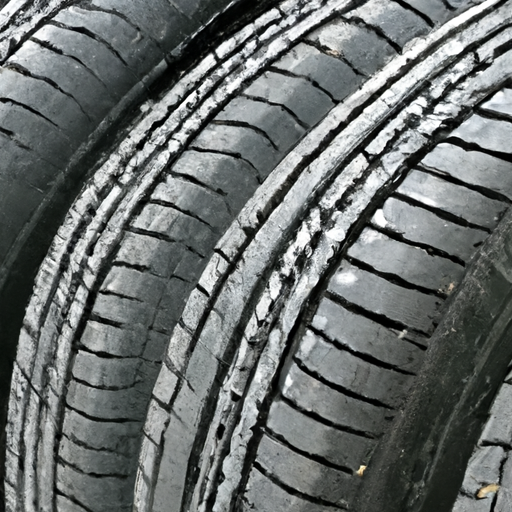Have you ever wondered about the differences between summer tires and all-season tires? While both types of tires are designed to provide traction and control on the road, there are distinct characteristics that set them apart. Understanding these differences can help you make an informed decision when it comes to selecting the right tires for your vehicle. In this article, we will explore the variances between summer tires and all-season tires, including their tread patterns, rubber compounds, performance in different weather conditions, and their suitability for specific driving styles.
Tread Composition
Rubber Compound
When it comes to tire composition, the rubber compound of the tread is a crucial factor to consider. Summer and all-season tires have different rubber compounds that optimize their performance in specific weather conditions. Summer tires are designed to have a softer rubber compound, which provides excellent grip and traction on dry roads. This softer compound allows the tire to conform better to the road surface, resulting in enhanced control and responsiveness. On the other hand, all-season tires have a harder rubber compound that is more durable and offers better longevity.
Tread Design
Apart from the rubber compound, the tread design is another essential aspect of tire composition. Summer tires usually feature a shallower and more open tread pattern. This design helps to evacuate water quickly and prevent hydroplaning on wet roads. Additionally, the shallower tread depth allows for a larger contact patch, which improves dry road grip and cornering stability. On the contrary, all-season tires have a more aggressive tread pattern with deeper grooves to enhance traction in a variety of weather conditions, including light snow and rain.
Tread Depth
Tread depth plays a significant role in a tire’s performance, particularly in terms of grip, traction, and longevity. Summer tires typically have a shallower tread depth compared to all-season tires. This design choice is made to maximize contact with the road surface, resulting in improved dry road grip and handling. However, the shallow tread depth of summer tires may not be as effective in dispersing water on wet roads, which can reduce their traction. On the other hand, all-season tires have deeper tread grooves, allowing for better water evacuation and enhanced grip on both wet and dry surfaces.
Performance in Different Weather Conditions
In terms of performance in different weather conditions, summer tires excel in warm and dry conditions. Their softer rubber compound and shallower tread depth provide impressive grip and handling on dry roads, ensuring precise and responsive cornering. However, summer tires may not perform as well in wet or cold weather, as their tread design and rubber compound are not optimized for these conditions. On the other hand, all-season tires are designed to provide satisfactory performance in a range of weather conditions, including light snow and rain. While they may not offer the same level of performance as summer tires on dry roads, all-season tires are a more versatile option for drivers who encounter varying weather conditions throughout the year.
Temperature Tolerance
Ideal Temperature Range
Tires are subjected to a wide range of temperatures, and their performance can be greatly affected by these temperature variations. The ideal temperature range for summer tires is between 40 and 100 degrees Fahrenheit (4.4 to 37.8 degrees Celsius). This temperature range allows the rubber compound of summer tires to maintain its flexibility and optimal grip on the road. However, it’s important to note that prolonged exposure to extremely high temperatures can cause the rubber to degrade and reduce the tire’s performance.
Effect of Temperature on Tread Compound
Temperature directly affects the characteristics of a tire’s tread compound. In hot weather, the rubber compound of summer tires becomes softer, which improves grip and traction. Conversely, in cold weather, the rubber compound of summer tires can become harder, resulting in reduced grip and less responsive handling. It is essential to match the temperature conditions with the appropriate tire type to ensure optimal performance and safety.
Performance in Hot Weather
Summer tires excel in hot weather due to their softer rubber compound. This softness allows the tire to grip the road surface more effectively, providing enhanced traction, cornering grip, and responsiveness. When the temperature rises, the rubber compound of summer tires maintains its flexibility, helping to prevent the tire from becoming excessively hard, which can result in decreased grip and handling performance.
Performance in Cold Weather
While summer tires perform admirably in hot weather, their performance can be compromised in cold weather conditions. The softer rubber compound of summer tires hardens in colder temperatures, reducing grip and traction. This can make driving on icy or snowy roads challenging and potentially hazardous. In cold climates, switching to winter or all-season tires is recommended for optimal performance and safety.

Grip and Traction
Dry Road Grip
When it comes to dry road grip, summer tires are the top performers. Their softer rubber compound and shallower tread depth allow for better contact with the road surface, resulting in excellent traction and grip. This enhanced grip ensures better acceleration, precise cornering, and shorter braking distances, all of which contribute to overall driving confidence and safety.
Wet Road Grip
While summer tires may excel in dry conditions, they may not provide the same level of grip on wet roads. The shallower tread depth and unique tread pattern of summer tires are not specifically designed to expel water rapidly, potentially leading to reduced traction and an increased risk of hydroplaning. In contrast, all-season tires feature deeper tread grooves and a more aggressive tread pattern that helps channel water away from the tire’s contact patch, improving traction and reducing the likelihood of hydroplaning.
Snow and Ice Grip
Summer tires are not designed for driving on snowy or icy roads. Their tread design and rubber compound are not optimized for cold conditions, making them less effective in providing grip and traction. In such weather conditions, winter tires are the recommended choice, as they feature a different tread design and a special rubber compound that remains pliable even in freezing temperatures. Winter tires are specifically engineered to provide superior grip, traction, and braking performance on snow and ice.
Hydroplaning Resistance
Hydroplaning is a significant concern when driving on wet roads. Summer tires, with their shallower tread depth, are more prone to hydroplaning compared to all-season tires. The deeper tread grooves of all-season tires help evacuate water more effectively, reducing the risk of hydroplaning. Additionally, all-season tires often feature siping – small slits in the tread blocks – which further enhance water dispersion and improve grip on wet surfaces.
Cornering and Handling
Stiffness
In terms of stiffness, summer tires are typically designed to be more rigid compared to all-season tires. This increased stiffness allows for enhanced handling precision and responsiveness while cornering. The stiffer sidewalls of summer tires reduce sidewall flex, providing better control and improved feedback to the driver. However, the increased stiffness can result in a slightly firmer ride compared to all-season tires.
Responsiveness
The responsiveness of a tire refers to how quickly it reacts to the driver’s inputs. Summer tires are known for their exceptional responsiveness, thanks to their softer rubber compound and stiffer construction. These characteristics allow summer tires to quickly adapt to changes in direction and provide precise, immediate feedback to the driver. When cornering or maneuvering at higher speeds, the responsive nature of summer tires ensures a more connected and engaging driving experience.
Precision
Precision in cornering is essential for both safety and performance. Summer tires offer excellent precision when it comes to cornering. The combination of their softer tread compound, stiffer sidewalls, and shallower tread depth enables summer tires to maintain maximum contact with the road surface during aggressive cornering maneuvers. This enhances overall stability, minimizes understeer or oversteer tendencies, and allows for precise control of the vehicle.
Braking Distance
Braking distance is a critical factor in assessing the overall performance of tires. Summer tires typically have shorter braking distances on dry roads compared to all-season tires. The softer rubber compound of summer tires offers increased grip, enabling them to grip the road surface more effectively during braking. This results in shorter stopping distances, providing drivers with enhanced safety and confidence, especially in emergency situations.

Speed Ratings
Performance at High Speeds
Speed ratings indicate the maximum speed at which a tire can safely operate. Summer tires often have higher speed ratings compared to all-season tires, emphasizing their focus on performance and handling at higher speeds. The construction and tread design of summer tires allow them to maintain stability and control even when driving at high speeds. It is crucial to ensure that the tire’s speed rating matches or exceeds the vehicle’s top speed capability to maintain optimal safety.
Effect on Cornering Ability
Higher speed ratings of summer tires can positively influence the vehicle’s cornering ability. The improved stability and enhanced grip of summer tires at high speeds allow for more confidence during cornering maneuvers. The higher speed ratings provide assurance that the tire can withstand the increased lateral forces encountered during spirited driving and aggressive cornering without compromising safety and performance.
Effect on Tread Wear
The speed rating of a tire does not directly affect its tread wear. However, it is worth considering that driving at higher speeds can increase the overall stress on the tire and potentially accelerate tread wear. Therefore, it is essential to balance the desire for high speed performance with the need to maintain proper tire maintenance and longevity.
Recommendations for Speed Ratings
When it comes to choosing the appropriate speed rating for your tires, it is crucial to consider the vehicle’s top speed capability and driving habits. If you frequently drive at high speeds or own a high-performance vehicle, summer tires with higher speed ratings are recommended to ensure optimal handling and safety. Conversely, if your driving consists primarily of city commuting and occasional highway driving within legal speed limits, all-season tires with lower speed ratings should be sufficient.
Noise and Comfort
Road Noise
Road noise can significantly impact the comfort and enjoyment of a driving experience. When comparing summer and all-season tires, it is subjective as to which one produces more road noise. However, with advancements in tire technology, many tire manufacturers have incorporated noise reduction technologies in both summer and all-season tires. These technologies, such as noise-absorbing foam or tread patterns designed to reduce noise, can effectively dampen road noise, providing a quieter and more comfortable ride.
Ride Comfort
Ride comfort is another critical aspect to consider when choosing tires. Both summer and all-season tires can provide a comfortable ride, depending on the specific tire model and its design. However, all-season tires generally prioritize ride comfort over performance, featuring a more flexible and forgiving construction. Conversely, some high-performance summer tires may sacrifice a certain degree of comfort for improved handling and grip. It’s important to strike a balance between the desired performance characteristics and the desired level of ride comfort.
Vibration Dampening
Vibrations can be felt through the steering wheel or the vehicle’s chassis, negatively impacting the overall driving experience. Both summer and all-season tires employ different methods to dampen vibrations. All-season tires typically have higher sidewall profiles, which provide more cushioning and absorb vibrations more effectively. Summer tires, with their stiffer construction and lower sidewall profiles, may transmit more road feedback and vibrations to the driver. However, advancements in tire technology have allowed some high-performance summer tires to incorporate vibration dampening features, providing a more comfortable and refined ride.
Noise Reduction Technologies
As mentioned earlier, noise reduction technologies have become prevalent in modern tire manufacturing. Both summer and all-season tires often incorporate noise-absorbing foam, variable pitch tread patterns, or other innovations to reduce road noise. These technologies help create a serene driving environment, minimizing fatigue and enhancing overall comfort. When selecting tires, it is worth considering the presence of noise reduction technologies to enjoy a quieter and more enjoyable driving experience.

Longevity and Durability
Tread Life
Tread life refers to the lifespan of a tire’s tread before it reaches the legal minimum depth. Generally, all-season tires tend to have a longer tread life compared to summer tires. The harder rubber compound and deeper tread depth of all-season tires contribute to their increased durability and longevity. However, it’s important to note that individual tire brands and specific models can significantly impact tread life. Regular tire maintenance, including proper inflation and regular rotations, can also play a crucial role in maximizing tread life.
Resistance to Wear
Wear resistance is an essential characteristic to consider when evaluating the longevity and durability of tires. While all tires will eventually wear down, some are more resistant to wear than others. All-season tires, with their harder rubber compound, tend to offer better wear resistance compared to summer tires. The softer rubber compound of summer tires, while providing excellent grip and handling, may wear down more quickly, particularly if driven aggressively. Regular tire rotations, proper tire maintenance, and responsible driving habits can help prolong tire life and ensure optimal performance.
Effect of Mileage on Performance
As tires wear down over time, their performance and capabilities can be affected. This is true for both summer and all-season tires. As the tread depth decreases, traction and grip on both wet and dry surfaces may diminish. Braking distances may also increase, and cornering stability may be compromised. It is important to monitor tread wear regularly and replace tires when they approach the legal tread depth limit to maintain optimal safety and performance.
Longevity Comparisons
When comparing the longevity of summer and all-season tires, all-season tires generally offer a longer tread life. The harder rubber compound and deeper tread grooves of all-season tires contribute to their increased wear resistance. However, it is worth noting that advances in tire technology have allowed some high-performance summer tires to offer respectable tread life while still providing excellent grip and handling. When selecting tires, consider your driving habits, the climate you drive in, and your expectations regarding tread life to make an informed decision.
Cost and Value
Price Range
The cost of tires can vary significantly depending on the brand, tire model, and tire size. Generally, summer tires tend to be more expensive than all-season tires due to their specialized performance capabilities. The high-quality materials, advanced construction techniques, and specific tread patterns contribute to the higher cost of summer tires. All-season tires, on the other hand, are more widely available and cater to a broader range of vehicles and driving conditions, making them generally more affordable.
Value for Money
When considering the value for money, it is essential to weigh the benefits and performance advantages of each tire type against their respective price points. Summer tires offer exceptional grip, handling, and performance in warm and dry conditions, making them highly desirable for driving enthusiasts or those seeking the ultimate in performance. All-season tires provide a more versatile option, with satisfactory performance in a variety of weather conditions while offering better longevity and value for money.
Considerations for Budget-conscious Buyers
For budget-conscious buyers, all-season tires often present a more cost-effective choice. They provide a balance of performance, longevity, and versatility at a more affordable price point. While they may not match the high-performance capabilities of summer tires on dry roads, all-season tires are reliable options for everyday driving needs. By carefully considering the specific needs and requirements of your driving habits, you can find the right balance between performance and budget.
Long-term Savings
While summer tires may have a higher upfront cost, they can potentially offer long-term savings in specific situations. The superior grip and traction provided by summer tires can result in shorter braking distances, potentially avoiding accidents and associated costs. Additionally, the increased performance and handling characteristics of summer tires can contribute to fuel efficiency improvements, translating into long-term savings on fuel expenses. It is essential to consider the overall cost-benefit analysis, including safety, performance, and long-term savings, when selecting tires.

Suitability for Different Vehicles
Passenger Cars
Both summer and all-season tires are suitable for passenger cars, but the choice depends on the driving conditions and performance priorities. Drivers who prioritize exceptional grip, cornering stability, and high-speed performance may opt for summer tires. These tires provide exhilarating driving experiences and maximize the potential of high-performance passenger cars. On the other hand, all-season tires are a popular choice for everyday commuting, providing a balance of performance, longevity, and versatility suitable for various driving conditions and vehicle types.
SUVs and Crossovers
SUVs and crossovers often need tires that can handle various road conditions, including light off-road driving. All-season tires are a popular choice for these vehicles, as they offer satisfactory performance in both dry and wet conditions, along with light snow traction. However, if you primarily drive in warm and dry climates, opting for high-performance summer tires designed for SUVs and crossovers can deliver improved grip, cornering stability, and enhanced performance.
Sports Cars
For sports car enthusiasts, the choice often leans towards summer tires to maximize the vehicle’s performance capabilities. Summer tires provide exceptional grip, handling, and responsiveness required for spirited driving and aggressive cornering. These tires are engineered to unlock the full potential of high-performance sports cars, ensuring an engaging and thrilling driving experience. However, it’s important to consider that summer tires are best suited for warm and dry conditions and may require switching to all-season or winter tires when encountering different weather conditions.
Trucks and Vans
Trucks and vans may have different requirements depending on their usage and geographical location. For typical city driving, all-season tires are a suitable choice, providing satisfactory performance in a range of weather conditions and versatile applications. However, if you frequently drive off-road or in challenging terrain, specialized tires such as all-terrain or mud-terrain tires may be more appropriate. These tires feature aggressive tread patterns, enhanced durability, and superior traction to handle various off-road conditions.
Changing Tires for Different Seasons
Switching to Summer Tires
Switching to summer tires is recommended for drivers who live in regions with warm and dry climates during the summer months. Summer tires deliver superior grip, handling, and performance in these conditions, ensuring an optimum driving experience. When switching to summer tires, it is crucial to store the winter or all-season tires properly to maintain their performance and longevity.
Switching to All-season Tires
For drivers who encounter mild or moderate winters and where heavy snowfall is not a concern, all-season tires are a practical choice. All-season tires offer satisfactory performance in both dry and wet conditions, along with light snow traction. They provide the convenience of not needing to switch out tires when the seasons change, making them a popular option for those who prefer simplicity and versatility.
Considerations for Geographic Location
Geographic location is a critical factor to consider when selecting tires. Drivers in regions with consistent warm and dry climates can benefit significantly from using summer tires year-round. However, those in regions with significant seasonal variations, including colder winters and heavy snowfall, should consider using winter tires during the colder months. In regions with moderate climates, all-season tires can provide acceptable performance year-round, eliminating the need for seasonal tire changes.
Timing of Tire Changes
The timing of tire changes depends on the local weather patterns and average temperatures. When switching to summer tires, it is crucial to ensure that consistently warm weather has arrived, and the chance of freezing or snowy conditions has passed. Conversely, when switching to winter or all-season tires, it is recommended to make the change before the onset of winter weather to ensure optimal safety and performance. Pay attention to weather forecasts and consult with local experts if you are unsure about the appropriate timing of tire changes in your region.


